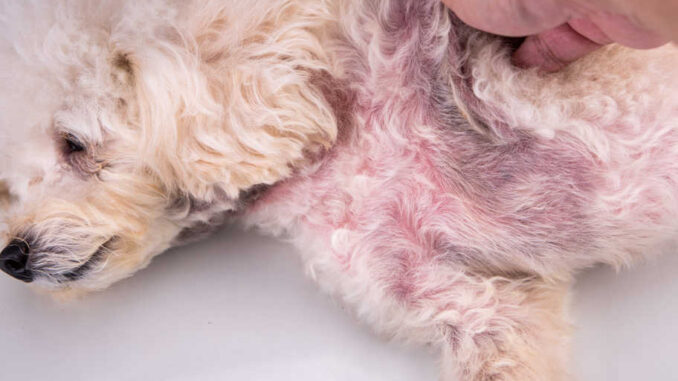
This article was updated on July 10th, 2023
A few months ago, we covered top causes of black spots on dog skin. In this article, we will dive deeper specifically into black spots due to yeast infections. These common skin infections are seen frequently in dogs, often as a result of an underlying allergy. Let’s start with a quick overview of yeast infection in dogs, and how they can lead to black spots.
What are yeast infections in dogs?
Yeast infections, also known as Malassezia dermatitis or yeast dermatitis, are common in dogs and generally affect the skin, especially paws, ears, and skin folds. These infections can be itchy and painful for dogs and extremely frustrating for pet parents. Often they are due to an underlying issue, such as an allergy, and may continue to recur until this has been resolved. Luckily, yeast infections are not contagious.
Black spots & accompanying symptoms with yeast infections
Hyperpigmentation, the medical term used to describe an increase of the pigmentation on a dog’s skin, which results in black spots on skin. These black spots can be the result of a yeast infection: this hyperpigmentation that occurs as a result of a yeast infection is known as “secondary hyperpigmentation”. It is triggered by inflammation and/or friction. Inflammation also often causes additional changes to the skin as we will see below.
Yeast infections typically present as itchy, red, and inflamed skin. However, if a yeast infection is left untreated for a long time, it can lead to secondary infections, black spots, and thickening of the skin, as shown on the pictures below.
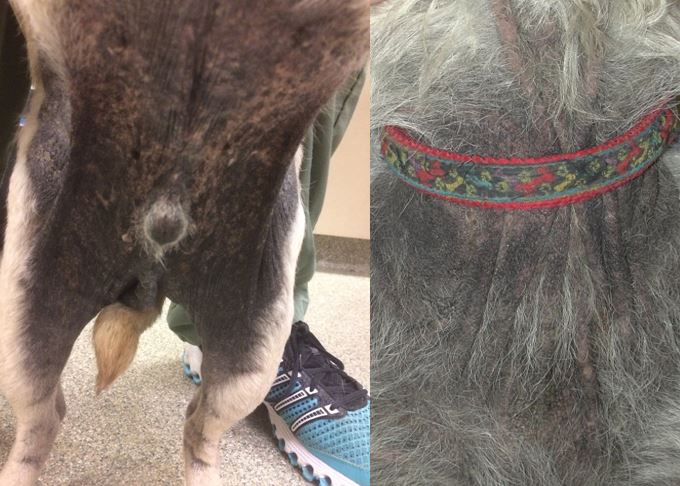
Photo: © Ian Brett Spiegel VMD, MHS, DACVD
Examples of black spots caused by yeast infections [With pictures]
This is an image of severe lichenification, or thickened skin (“elephant skin“), that is commonly seen with chronic yeast infections:
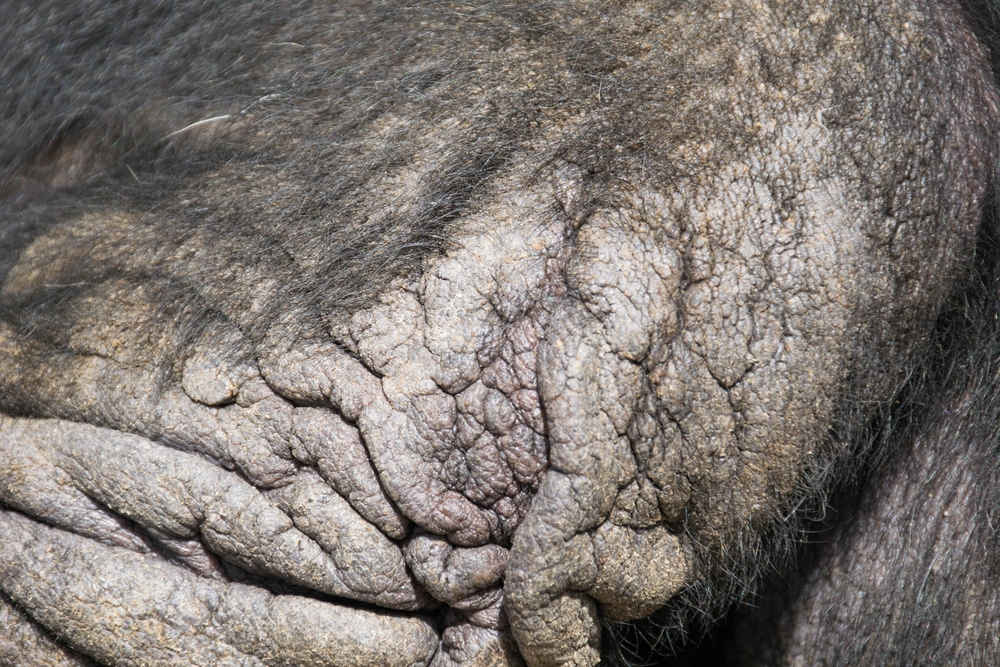
Images of hyperpigmentation: the two images below show black spots along with other symptoms of skin infection and inflammation caused by underlying allergies:
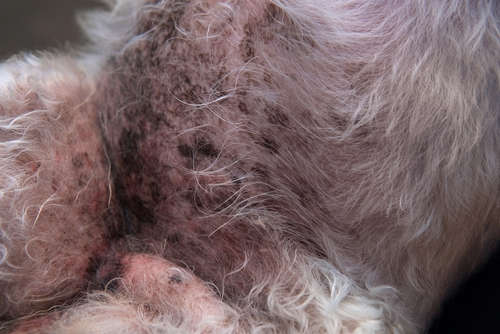
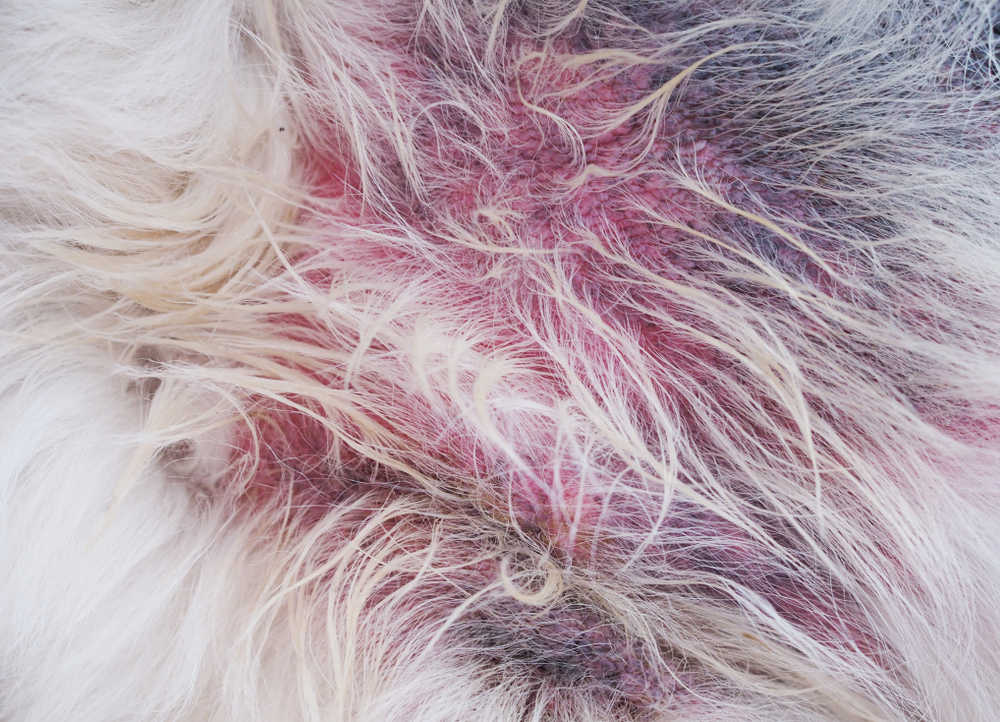
The image below shows severe hyperpigmentation, thickened skin, and inflammation. This is likely due to a chronic yeast infection.
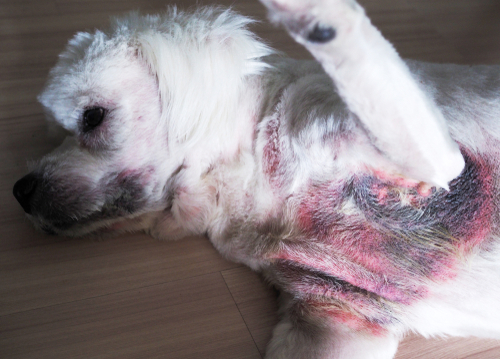
Additionally, the inflammation and irritation from a skin infection can lead to excessive licking and scratching by the dog, causing trauma to the skin and leading to sores, scabs, and eventual discoloration or dark spots.
Dermatophyte (ringworm) is another fungal infection that can present with increased pigmentation. This is contagious to other dogs and even humans. This is reported more in cats, but is seen in dogs as well.
Location of black spots on dogs as a result of yeast infections
Yeast infections can occur anywhere on a dog’s body, but they occur most frequently on:
- Paw & paw pads: paw pads are a common spot where yeast infections can develop.
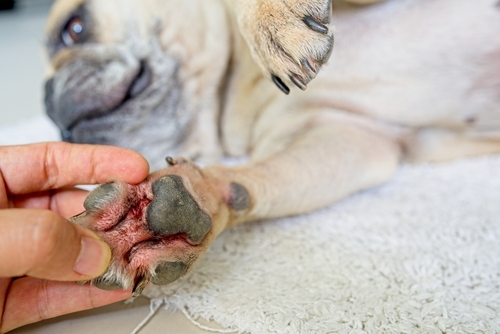
Facial skin folds are also a common spot for yeast infections. The black fur on this dog’s paw below is due to salivary staining, from chewing and biting – due to Malassezia, the culprit of many yeast infections. This often occurs secondary to an allergy or skin infection:
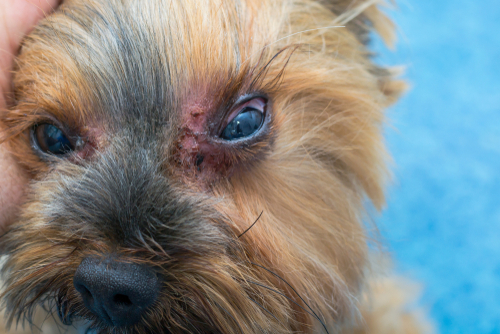
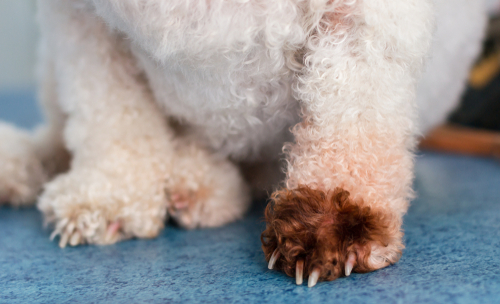
How to help your dog at home with black spots from yeast infections
Mild yeast infections may respond to bathing with a calming shampoo or antifungal shampoo. Spot treatment for small areas of infection may respond to a mixture of vinegar and water. You can also check out our guide to home remedies for ear infections. Consider a product like this, which contains ketoconazole to help target yeast.
- While Other Dog Ear Drops Solutions Are Too Harsh For Your Furry Friends, Leading To Allergic Reactions Or Worse, Pet MD’s Mild, Non-stinging Tris Flush Ear Cleaner For Dogs & Cats Was Specially Formulated To Be Gentle But Effective, Flushing Out Nasty Infections From Your Dog Ears, Eliminating The Root Cause Of Your Dog Ear Infection.
However, most yeast infections require a veterinary exam and treatment. Dogs with yeast infections also commonly have bacterial infections of the skin or ears, and may need antibiotics as well as medications to help treat yeast and decrease inflammation. Putting a cone on your dog while you are waiting for your veterinary appointment can help prevent them from causing additional trauma to their skin and ears.
While it is not possible to prevent infections in every dog, the following at-home recommendations may be helpful, especially if your dog is predisposed to skin infections:
- Feed a healthy, balanced commercial dog food or a prescription diet if recommended by your vet. You may also wish to ask your vet about supplements such as omega-3 fatty acids to help support skin health.
- Wipe off paws after coming inside to help remove allergens.
- Clean your dog’s ears and/or pluck ear hair if recommended by your vet.
- Make sure to fully dry your dog after swimming or bathing.
- Use year-round flea prevention for all pets in the household.
- Discuss underlying allergies with your vet and come up with a treatment plan.
Will black spots from yeast infections go away on their own?
The black spots caused by a skin infection will resolve only after the underlying issue is identified and treated. This process may take many months. If left untreated, the inflammation and hyperpigmentation will continue to worsen.
Signs that black spots need veterinarian help
Black spots on dog skin, along with the following clinical signs, indicate that a trip to the vet is needed.
- Your dog is in pain or is scratching/licking so excessively that it is affecting their daily life
- Skin condition is not improving or is worsening
- You see discharge, pus, or sores on the skin
- The pigmented area is raised or increasing in size
Additionally, there are other possible causes of dark spots on a dog’s skin which also require veterinary attention. Cancerous or benign skin growths can occur anywhere on your dog’s body and may be pigmented. Any new lump or bump should be evaluated by a vet. Other possible causes include comedones (blackheads), fleas, or normal skin pigment.
Other Clinical signs of yeast infections in dogs
The clinical signs of a yeast infection are similar to other types of skin infections. In fact, your vet will have to do testing to determine if a skin infection is caused by yeast, bacteria, or both. Clinical signs of skin infection include:
- Pruritus (itchy skin)
- Erythema (redness)
- Scales, crusting, sores, and flakey skin
- Hair loss
There are also a few clinical signs that are especially typical of yeast infections:
- Musty odor
- Lichenification (thickened skin) also known as elephant skin
- Hyperpigmentation (black spots or discoloration on skin)
If a yeast infection occurs in the ear, it will cause clinical signs of ear infection such as head shaking, scratching at ears, and debris or discharge from the ears.
Top causes of yeast infections in dogs
Healthy dogs have bacteria and yeast (such as Malassezia) that live on the skin without causing illness. If the skin changes (such as an increase in oil production) or the immune system is suppressed, these organisms can increase in number and cause infection.
Allergies
Dogs can be allergic to fleas, something in their diet (food allergy), or something in the environment (atopy). While allergies in people tend to cause sniffles, allergies in dogs generally affect their skin. Allergies can not only make a dog itchy and uncomfortable but can lead to secondary and recurrent skin and ear infections. Severity can range from a dog who frequently licks their paws to an animal suffering from severe hair loss, infection, and trauma to the skin. Some animals can actually be allergic to the yeast itself.
Seborrhea
Seborrhea can cause flakey and scaly skin. It can also affect oil production in the skin, leading to a greasy environment, which can predispose dogs to yeast overgrowth.
Immunosuppression or other underlying medical conditions
Underlying medical conditions ranging from immune-mediated disease, immunosuppression, hypothyroidism, Cushing’s Disease, liver disease, and cancer, can also be contributing factors. In addition, pain or anxiety leading to excessive licking or chewing can damage the skin and lead to infection.
Certain medications
Long-term use of steroids or antibiotics can also alter the normal balance of bacteria and yeast on the skin.
Excessive washing or grooming
Excessive washing or grooming, especially if it leaves additional moisture on the skin or in the ears, can also upset the skin’s delicate balance.
Breed predisposition
Certain breeds are genetically predisposed to yeast infections, including West Highland White Terrier, Basset Hound, Cocker Spaniel, Silky Terrier, Australian Terrier, Maltese, Chihuahua, Poodle, Shetland Sheepdog, Lhasa Apso, and Dachshund.
How vets diagnose yeast infections
Your vet may diagnose yeast dermatitis based on history, a nose-to-tail physical exam, an otoscopic (ear) exam, and several possible diagnostic tests.
- Cytology – Your vet will collect a sample from the skin for evaluation under the microscope. This may be done by pressing a glass microscope slide against the skin or using a piece of tape to collect skin cells. In the case of an ear infection, they will take a swab of debris from your dog’s ear. Evaluation under the microscope should determine if it is yeast, bacteria, or both that are causing the infection.
- Skin scraping – This is another way to collect a small skin sample to look for the presence of yeast organisms as well as mites (Demodex or Scabies), which can predispose dogs to skin infections.
- Biopsy – In more severe cases or those resistant to treatment, a larger piece of skin may be removed via a punch biopsy.
If your dog has had chronic or recurrent skin infections, your vet may recommend further testing to help them identify and treat the underlying cause.
- Bloodwork – If your vet is concerned about systemic disease that may predispose your dog to skin infections, such as hypothyroidism or Cushing’s Disease, bloodwork may be indicated.
- Allergy testing – Allergy testing may involve referral to a dermatologist for a skin test, a blood test, or a feeding trial with a hypoallergenic diet.
Veterinarian treatments for yeast infections
Treatment will depend on the severity and location of the infection, as well as any possible underlying causes. Often a combination of therapy is used. Common treatments for yeast infections include:
- Topical medications – Ear infections or localized infections (affecting only one area of the body) are generally treated with a topical ointment containing antifungals, antibiotics, and anti-inflammatories. If the yeast infection is affecting a larger area of your dog’s skin, then medicated shampoo is highly recommended. These shampoos contain ingredients such as chlorhexidine, miconazole, or ketoconazole. To be most effective, shampoo needs to be applied twice weekly and sit on the skin for ten minutes before rinsing. Other options for topical treatment may include medicated mousse, sprays, or wipes.
- Oral antifungals – For severe infections, oral antifungal medications like ketoconazole may be needed. These medications often need to be given for long periods of time (weeks to months) and may cause side effects or affect liver function. Therefore your veterinarian may recommend bloodwork before and during the course of treatment.
- Antibiotics – Dogs with yeast infections often have concurrent bacterial infections of the skin or ears; therefore topical and/or oral antibiotics may be needed as well.
- Management of inflammation and allergies – If your dog is extremely itchy and uncomfortable they may be prescribed additional medications such as Apoquel, Cytopoint, or steroids. These medications can also help manage symptoms of environmental allergies. If a food allergy is suspected, you may need to feed a prescription hydrolyzed protein diet.
The cost of treatment will vary significantly based on the severity of the infection and the specific diagnostic tests and treatments recommended by your vet. You should notice significant improvement within the first week of starting treatment. The black spots themselves may take months to resolve.
Related posts about brown or black spots:
Dog’s Belly with Black or Brown Spots
Related posts about yeast infections:
Disclaimer: This website's content is not a substitute for veterinary care. Always consult with your veterinarian for healthcare decisions. Read More.




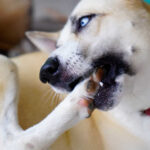
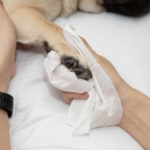

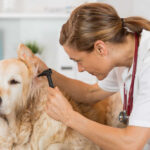
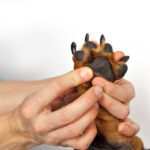
Be the first to comment